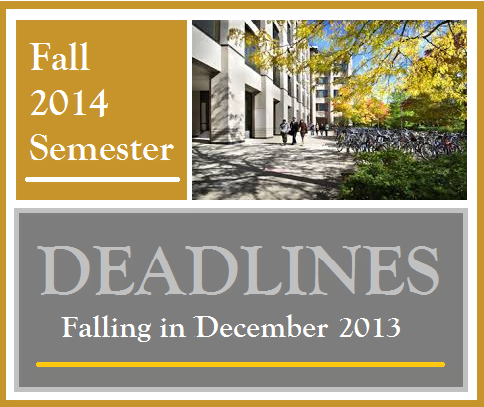The month of June is now approaching which means the spring 2015 application process should now begin. As per our tradition we are publishing the spring 2015 university deadlines on this blog. Keep in mind some universities update deadlines on their websites at different times during the academic year.
 The deadlines mentioned below are for the graduate school only. The department deadlines differ from the graduate school deadlines and hence you should cross check with your respective department for confirmation.
The deadlines mentioned below are for the graduate school only. The department deadlines differ from the graduate school deadlines and hence you should cross check with your respective department for confirmation.
Deadlines in June
1. University of Maryland, Baltimore County 1-Jun
2. Texas Tech University 15-Jun
3. University of Tennessee, Knoxville 15-Jun
Deadlines in July
1. Florida Institute of Technology 1-Jul
2. University of Pittsburgh 1-Jul
3. Washington State University, Pullman 1-Jul
4. North Carolina State University 15-Jul
5. University of Illinois, Chicago 15-Jul
6. University of Rhode Island, Kingston 15-Jul
Deadlines in August
1. Kansas State University 1-Aug
2. North Dakota State University, Fargo 1-Aug
3. University of Michigan, Dearborn 1-Aug
4. Western Michigan University, Kalamazoo 1-Aug
5. Wichita State University 1-Aug
6. Rensselaer Polytechnic Institute 15-Aug
7. South Dakota School of Mines & Tech 15-Aug
8. South Dakota State University, Brookings 15-Aug
9. University of Kentucky, Lexington 15-Aug
10. San Francisco State University 31-Aug
Deadlines in September
1. East Carolina University 1-Sep
2. George Washington University 1-Sep
3. Illinois Institute of Technology, Chicago 1-Sep
4. Indiana University, Bloomington 1-Sep
5. Lamar University 1-Sep
6. Mississippi State University 1-Sep
7. Oakland University, Rochester 1-Sep
8. University of Alaska, Fairbanks 1-Sep
9. University of Nebraska, Lincoln 1-Sep
10. University of Oklahoma, Norman 1-Sep
11. University of South Carolina, Columbia 1-Sep
12. University of Texas, Dallas 1-Sep
13. University of Texas, San Antonio 1-Sep
14. Virginia Polytechnic Inst. & State Univ. 1-Sep
15. California State University, Chico 15-Sep
16. Northeastern University, Boston 15-Sep
17. Texas A & M University, Kingsville 15-Sep
18. Tufts University 15-Sep
19. University of North Carolina, Greensboro 15-Sep
20. University of North Texas, Denton 15-Sep
21. California State University, Fresno 30-Sep
22. California State University, Northridge 30-Sept Online Application, 31-Oct Documents Submission
Deadlines in October
1. California State University, Long Beach 1-Oct Online Application, 15-Oct Documents Submission
2. California State University, Sacramento 1-Oct
3. Case Western Reserve University 1-Oct
4. Eastern Michigan University 1-Oct
5. Florida International University 1-Oct
6. Illinois State University, Normal 1-Oct
7. Indiana University Purdue University 1-Oct
8. Minnesota State University, Mankato 1-Oct
9. Northern Illinois University, Dekalb 1-Oct
10. Oklahoma State University, Still Water 1-Oct
11. Old Dominion University, Norfolk 1-Oct
12. Oregon State University, Corvallis 1-Oct
13. Pennsylvania State Univ., University Park 1-Oct
14. Southern Illinois University, Edwardsville 1-Oct
15. State University of New York, Stony Brook 1-Oct
16. Stevens Institute of Technology 1-Oct
17. Tennessee Technological University 1-Oct
18. University of Arkansas, Little Rock 1-Oct
19. University of Colorado, Denver 1-Oct
20. University of Detroit, Mercy 1-Oct
21. University of Houston, University Park 1-Oct
22. University of Idaho, Moscow 1-Oct
23. University of Iowa, Iowa City 1-Oct
24. University of Louisiana, Lafayette 1-Oct
25. University of Massachusetts, Amherst 1-Oct
26. University of Nevada, Las Vegas 1-Oct
27. University of New Mexico, Albuquerque 1-Oct
28. University of North Carolina, Charlotte 1-Oct
29. University of Texas, Arlington 1-Oct
30. University of Virginia, Charlottesville 1-Oct
31. West Virginia University, Morgan Town 1-Oct
32. Worcester Polytechnic Institute 1-Oct
33. California State University, Los Angeles 15-Oct
34. Cleveland State University 15-Oct
35. Duke University 15-Oct
36. Marquette University 15-Oct
37. Texas State University 15-Oct
38. University of Georgia 15-Oct
39. University of South Florida, Tampa 15-Oct
40. Villanova University 15-Oct
41. California State University, Fullerton 17-Oct
Deadlines in November
1. University of San Francisco Nov
2. Florida State University 1-Nov
3. Idaho State University 1-Nov
4. Monmouth University 1-Nov
5. University of Louisville, Louisville 1-Nov
6. University of Miami, Coral Gables 1-Nov
7. University of Utah, Salt Lake City 1-Nov
8. University of Wyoming, Laramie 1-Nov
9. Vanderbilt University 1-Nov
10. Arkansas State University 14-Nov
11. City University of New York, City College 15-Nov
12. Missouri Univ. of Science & Tech., Rolla 15-Nov
13. Montana State University, Bozeman 15-Nov
14. New Jersey Institute of Technology 15-Nov
15. University of Massachusetts, Dartmouth 15-Nov
16. Marist College, Poughkeepsie 30-Nov
17. Southern Methodist University 30-Nov
Deadlines in December
1. University of Alabama, Birmingham Dec
2. University of Alabama, Tuscaloosa Dec
3. Lehigh University 1-Dec
4. Louisiana Tech University, Ruston 1-Dec
5. New York Institute of Technology 1-Dec
6. Polytechnic Inst. of New York Univ, Brooklyn 1-Dec
7. University of Houston, Clear Lake 1-Dec
8. University of South Alabama, Mobile 1-Dec
9. University of Southern California 1-Dec
Deadlines in January
1. Louisiana State University, Baton Rogue 1-Jan
2. Wayne State University 1-Jan
3. New Mexico Institute of Mining & Technology 2-Jan
4. Santa Clara University 10-Jan
5. New Mexico State University, Las Cruces 27-Jan
Deadlines in February
1. University of Maryland, College Park 7-Feb
Rolling Deadlines
1. University of Toledo Rolling
2. Wright State University, Dayton Rolling
Under rolling deadlines there is no fixed application deadline declared by the university. Applications are accepted anytime till the seats for that particular semester are full.
We wish you all the best!










